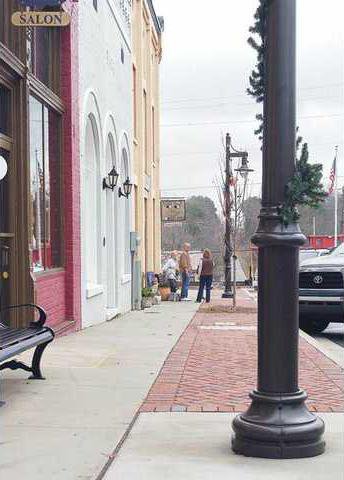FLOWERY BRANCH — A $321,000 grant used to spruce up downtown turned into a project that ended up costing Flowery Branch an additional $166,333, a year-end audit shows.
But city officials, who are moving money from the water/sewer fund to the grant fund to cover the shortfall, say the finding was no surprise.
"The first problem was the budget (for the work) was several years out of date," City Manager Bill Andrew said Wednesday.
The city had the Georgia Department of Transportation Enhancement Grant for several years before it began the work.
The "streetscape" project entailed landscaping, widening sidewalks on the first block of Main Street off Railroad Avenue, installing new streetlights and benches with a historic flavor, and adding parking spaces.
The city paid for power and communication lines to be buried underground.
Construction on the first phase of the project began in early fall of 2007 and was completed in February.
A ribbon-cutting ceremony in June — featuring ice cream and remarks by dignitaries, including former DOT Chairman Mike Evans — marked the completion of the project.
Andrew said rising construction costs during the time that the city’s grant lay dormant also contributed to increased project amounts.
"Concrete and asphalt and all that went up in price almost 100 percent ... and (Hurricane Katrina) also caused commodities to shoot through the roof at the exact time we were buying them," he said.
And the city also made some project changes of its own.
"We decided to do some work around (the) Major McGill’s (building) on Church Street and Main Street ... and it gave our police department some better parking on Church Street," Andrew said.
He said the city was paying for the overspending out of the city’s general fund.
"We overspent what revenue we had for the grant, and it showed up in the audit," Andrew said. "It’s not like that was spending we didn’t know about. It’s just that it was coded to the grant instead of the general fund."
Last year’s budget, which ended June 30, took on three unexpected items: the purchase of two buildings on Main Street for the city offices, water and sewer department salaries not covered by utility revenues and the streetscape project.
"At the end of the year, you always have overspending or underspending in various funds," Andrew said.
In a discussion of the matter with City Council last week, Planner Director James Riker said the city needs to guard against how much value it gets out of such grants.
"You’d be shocked at how much money it takes to really make sure that (a project) looks like it’s supposed to look," Riker said.
If the city had used just what grant money it had been given, "you wouldn’t have the feel and look (downtown) that you have now."

